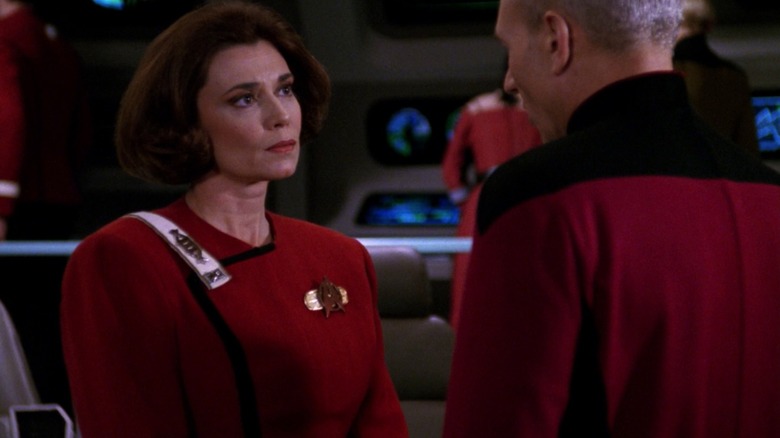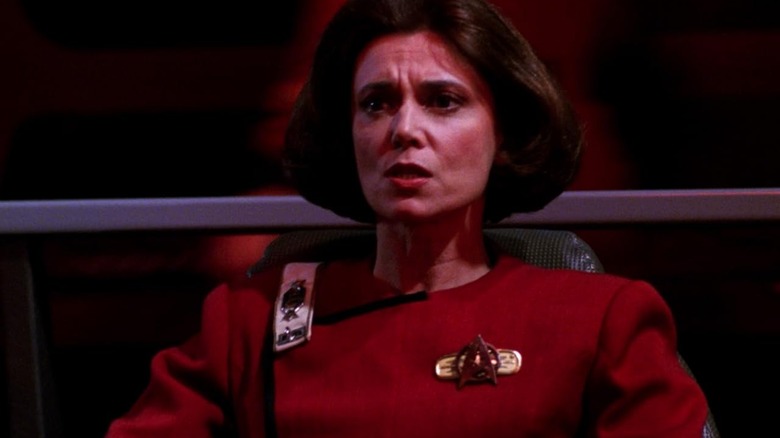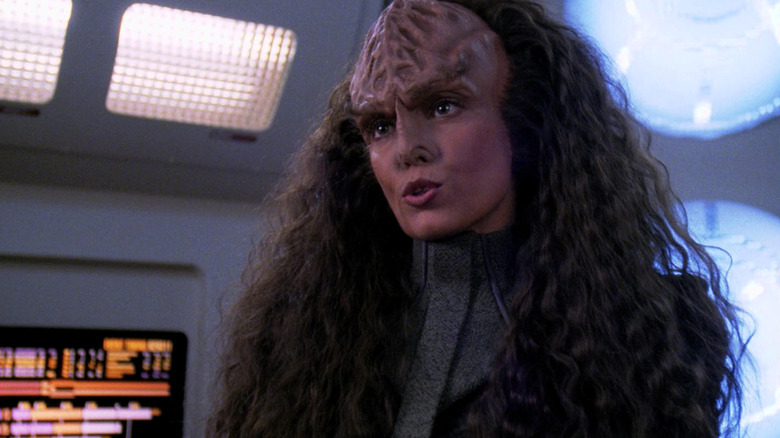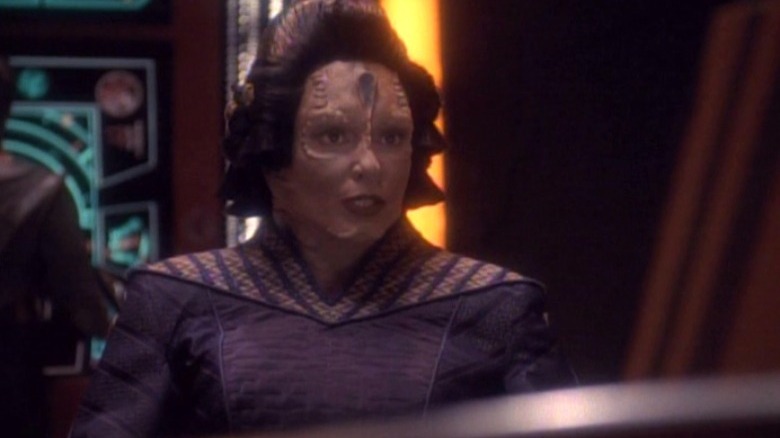The Actress Behind Star Trek's Captain Garrett Returned In Two Unrecognizable Roles
Captain Rachel Garrett was the commanding officer of the U.S.S. Enterprise-C, a ship that infamously met a grisly fate. In the 1990 "Star Trek: The Next Generation" episode "Yesterday's Enterprise" — often called one of the best episodes of the show — the once-thought-destroyed Enterprise-C flew threw a time portal, landing itself 20 years in the future, smack in the middle of the 24th century timeline of "Next Generation." It seems, however, that when the Enterprise-C vanished from its timeline 20 years ago, it also exited a crucial battle with the Romulans. The ship's disappearance negatively changed the outcome of the battle and led to a decades-long war. The Enterprise-D of "Next Generation," thanks to causality, was instantly transformed into a stern warship, one of the last surviving fighting forces in a failing Federation military.
The situation was overseen by Captain Garrett, played by actress Tricia O'Neil. O'Neil played Garrett's part well, showing the character being torn between saving her crew and ship, or making the hard decision to go back to her original time and restore a timeline she had never experienced.
"Star Trek," it should be noted, has long been notoriously good to its actors, often asking that they return time and again, often to play very different roles. An actor may be a Vulcan one week and a Klingon the next. The same is true of O'Neil. Trekkies may instantly recognize her as Captain Garrett, but fewer might piece together that she also played the Klingon scientist Kurak in the episode 1993 "Suspicions" as well as the Cardassian observer Korinas in the 1994 "Star Trek: Deep Space Nine" episode "Defiant."
O'Neil spoke with StarTrek.com in 2013 about all three parts.
Captain Rachel Garrett
O'Neil said that playing a starship captain on "Star Trek" was a hefty job in itself, but knowing that she was to be the captain of the U.S.S. Enterprise was definitely worth noting. She sank into the role, trying to affect a real sense of authority and confidence. She disappeared into the world of "Star Trek," believing every bit of the complex sci-fi fantasy world that had been created. She said:
"I knew what that captain's chair was and when I, Tricia O'Neil, sat in that chair, I understood the importance of it. A lot of people work on these shows — people who build the sets and the props and make the costumes — and the work is so good you can absolutely suspend your disbelief of things. Everything becomes very real and, if you let go of not believing, you can sail right into a whole world. Sitting in that chair as captain of the U.S.S. Enterprise, that's who I was for a week or so."
Her dedication certainly comes across in her performance. Captain Garrett is an intense character who takes her situation seriously. She needed to be a real captain with her own crew and command style, rather than merely be an adjunct to the decisions of Captain Picard (Patrick Stewart). Naturally, she loved it, saying:
"It was an extraordinary experience. All of the people involved were so talented: the writers, the actors, the set people. Everything is so much bigger than you, but it supports who you are being at the time, for the story."
Garrett wasn't referred to again until the third season of "Star Trek: Picard" in 2023, but her name is now well remembered by Trekkies the world over.
Kurak
In the episode "Suspicions," Dr. Crusher (Gates McFadden) finds herself fascinated by a visiting Ferengi scientist named Dr. Reyga (Peter Slutsker) who has invented a new kind of starship shield that allows people to fly into the corona of a star. When the shield is tested, however, it fails and accidentally kills the shuttle pilot Jo'Bril (James Horan), another scientist who also wanted to see Reyga's experiment succeed. Reyga was so despondent that he seemingly took his own life, but Dr. Crusher suspects foul play and begins investigating the other scientists on the ship who might have killed Reyga out of professional jealousy. The Klingon scientist was Kurak, a spiky and defensive character who might have had something to hide.
O'Neil understood the professional pressures and inner conflicts of Kurak, and the actress used her time in the makeup chair to get into character. She said:
"The makeup was difficult, but once I saw it, it was such a support to believe the world, to get into character. I knew Klingons and I knew the difficulty this particular Klingon was involved in because she was advancing. She had the great weight on her shoulders of being intelligent, of being a scientist, and she was crossing barriers. But she was still a Klingon, so she was very ... not savage, but physical, where a lot of muscle was still involved, even though she was crossing over into being a scientist."
O'Neil added that she had to play the part as if the character were constantly holding herself back, saying:
"[A]s passionate as she was, she also had to be restrained in a way that was not easy for her. So, when she pushed Dr. Crusher around, she was being jousted with, and that tested her."
Korinas
In the "Star Trek: Deep Space Nine" episode "Defiant," O'Neil returned as a Cardassian character named Korinas, a member of the Obsidian Order. The Obsidian Order is essentially the Cardassian CIA, but one that most frequently spies on its own people. In "Defiant," the rogue Starfleet officer Thomas Riker (Jonathan Frakes) steals the U.S.S. Defiant — DS9's specialized warship — on behalf of a separatist faction called the Maquis. When the Cardassian Gul Dukat (Marc Alaimo) pursues Riker into a seemingly uninhabited region of Cardassian Space, he is confronted by his observer, Korinas, who tells him not to proceed. Something fishy is going on.
O'Neil recalls the tone on the "Deep Space Nine" set to be very different from that of "Next Generation," and that, again, her makeup was confining. She ended up channeling the physical rigidity of her makeup and costume into character traits, saying:
"It was a darker set, a more closed-in feeling, though I think that may have had something to do with the makeup. My makeup was confining. I'd also done a makeup role for 'Babylon 5,' but the Cardassian makeup was difficult. It was hard breathing. You felt trapped in the confines of the costume, too. It was rigid. The character had an undercurrent of falsehood, somehow, and as an actor that makes you tense and apprehensive and withdrawn in some ways."
O'Neil, a professional who worked consistently from 1970 until her retirement in 2001, knew how to think about characters, saying:
"[F]or me, a lot depends on the internal things that are going on with a character. That affects how you feel when you look at yourself in the mirror. How the makeup makes you appear affects how you think of a character. It's all a thinking process."



